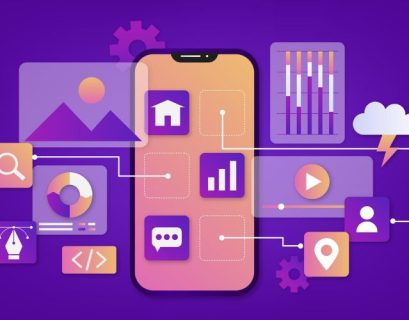In the fast-evolving world of mobile app development, creating apps that cater to diverse platforms has become crucial. Cross-platform frameworks are a game-changer, allowing developers to write a single codebase that runs seamlessly on multiple platforms, such as iOS and Android. For businesses in Harrow seeking App Development Services in Harrow, understanding these frameworks is essential for building efficient, cost-effective, and user-friendly apps.
Here, we explore the top 10 cross-platform app development frameworks that are set to dominate in 2025, along with their features, benefits, and use cases.
1. Flutter
Flutter, developed by Google, is one of the most popular cross-platform frameworks. Known for its fast development cycles and customizable widgets, Flutter allows developers to create visually stunning and natively compiled applications for mobile, web, and desktop from a single codebase.
- Key Features:
- Hot Reload: Instantly see changes in the app during development.
- Rich UI Widgets: Offers customizable, pixel-perfect widgets.
- Great Performance: Delivers a smooth user experience.
- Use Case: Flutter is ideal for startups and enterprises aiming to create interactive and visually appealing apps.
2. React Native
Backed by Facebook, React Native remains a favorite among developers. It allows the creation of robust mobile applications using JavaScript and React. Its reusable components make development efficient and cost-effective.
- Key Features:
- Modular Architecture: Enhances app flexibility.
- Strong Community Support: Offers solutions for common issues.
- Third-Party Plugins: Easy integration of additional features.
- Use Case: Perfect for apps requiring high performance, such as e-commerce or social networking platforms.
3. Xamarin
Xamarin, a Microsoft-owned framework, is known for creating native-like applications using C#. It allows access to native APIs, ensuring performance comparable to fully native apps.
- Key Features:
- Code Sharing: Share up to 90% of code across platforms.
- Comprehensive Libraries: Includes .NET libraries for enhanced functionality.
- Seamless Testing: Integrates with Visual Studio App Center for testing.
- Use Case: Ideal for enterprises looking for scalable and secure app development solutions.
4. Ionic
Ionic is a hybrid framework that enables developers to create mobile, desktop, and progressive web applications. It is powered by web technologies like HTML, CSS, and JavaScript, making it an accessible choice for web developers venturing into app development.
- Key Features:
- Built-in UI Components: Includes pre-designed components for faster development.
- Progressive Web App Support: Simplifies web-to-mobile transitions.
- Native Plugins: Extends functionality with features like GPS and camera.
- Use Case: Best for apps with simpler requirements, such as booking or informational apps.
5. Apache Cordova
Cordova, previously known as PhoneGap, is a developer-friendly framework that leverages standard web technologies to build mobile applications. Its flexibility and simplicity make it a top choice for those transitioning from web development to mobile.
- Key Features:
- Access to Native Device Features: Camera, GPS, and more.
- Extensive Plugin Library: Expand app functionality effortlessly.
- Lightweight: Ensures faster app load times.
- Use Case: Suitable for small-scale projects or apps requiring basic functionalities.
6. PhoneGap
PhoneGap is a subset of Apache Cordova, maintained by Adobe, and is known for its ability to create lightweight mobile apps quickly. It is often used for apps with limited complexity.
- Key Features:
- Cross-Platform Compatibility: Supports iOS, Android, and Windows.
- Developer-Friendly: Leverages familiar web languages.
- Open Source: Encourages customization and flexibility.
- Use Case: Best for prototyping or creating simple apps with minimal resources.
7. NativeScript
NativeScript simplifies the development of native-like applications using JavaScript or TypeScript. It allows developers to reuse existing skills to create apps that deliver a truly native experience.
- Key Features:
- Native API Access: Provides direct access to native platform APIs.
- No Web Views: Apps run natively, enhancing performance.
- Comprehensive Plugins: Expand app functionality with ease.
- Use Case: Ideal for apps requiring heavy use of device capabilities like AR or geolocation.
8. Kotlin Multiplatform Mobile (KMM)
Kotlin Multiplatform Mobile is a newer framework gaining traction for its ability to share logic across Android and iOS applications. Developed by JetBrains, KMM streamlines development and ensures consistency.
- Key Features:
- Shared Logic: Write business logic once and reuse it across platforms.
- Easy Integration: Works well with existing native codebases.
- Strong IDE Support: Fully supported by IntelliJ IDEA and Android Studio.
- Use Case: Suitable for teams already using Kotlin for Android development.
9. Unity
Although primarily known for game development, Unity is making waves in mobile app development due to its advanced rendering capabilities and support for augmented reality (AR).
- Key Features:
- 3D and 2D Rendering: Build visually immersive applications.
- AR/VR Support: Ideal for cutting-edge app experiences.
- Multi-Platform Deployment: Deploy apps across devices seamlessly.
- Use Case: Best for apps requiring heavy graphics, such as games or interactive AR applications.
10. Sencha Ext JS
Sencha Ext JS is a robust framework designed for creating data-intensive, enterprise-grade applications. Its advanced grid and charting features make it stand out for business apps.
- Key Features:
- Advanced Data Management: Excellent for handling large datasets.
- Adaptive Design: Creates apps that work on any device.
- Extensive Libraries: Speeds up development with pre-built components.
- Use Case: Ideal for enterprise apps with complex data visualization needs.
Why Cross-Platform Frameworks Are Essential
Cross-platform app frameworks are pivotal for businesses in today’s fast-paced digital era. They provide:
- Cost Efficiency: Save resources by using a single codebase.
- Faster Development: Reduce time-to-market significantly.
- Consistency: Offer a uniform experience across devices and platforms.
For businesses in Harrow, partnering with experts offering App Development Services in Harrow ensures that you can leverage the benefits of these frameworks effectively.
How to Choose the Right Framework?
When selecting a cross-platform framework, consider the following factors:
- Project Requirements:
Define your app’s functionality, target audience, and complexity. - Team Expertise:
Choose frameworks aligned with your developers’ skill sets. - Budget and Timeline:
Factor in development costs and delivery schedules. - Future Scalability:
Ensure the framework can handle your app’s growth.
Conclusion
Cross-platform app development frameworks have revolutionized the way apps are built, offering unparalleled flexibility, cost savings, and efficiency. In 2025, frameworks like Flutter, React Native, and Xamarin will continue to empower developers and businesses to create apps that cater to diverse platforms and user bases.
For businesses in Harrow, collaborating with professional App Development Services in Harrow is the key to leveraging these frameworks effectively. By understanding the unique strengths and use cases of each framework, you can make informed decisions to deliver high-performing, scalable, and engaging mobile applications.










